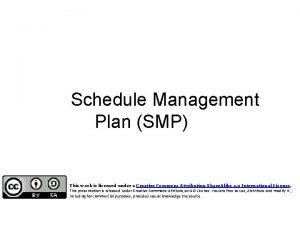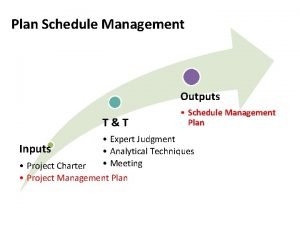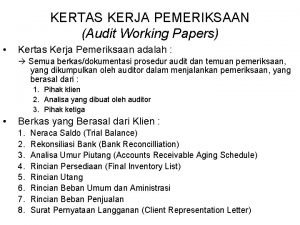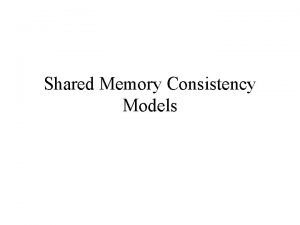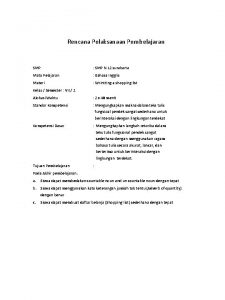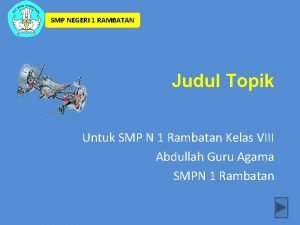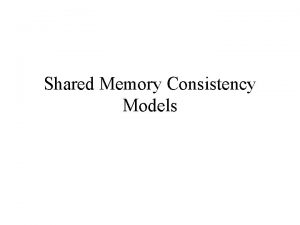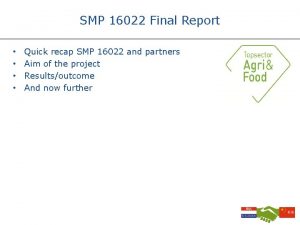Schedule Management Plan SMP This work is licensed










- Slides: 10

Schedule Management Plan (SMP) This work is licensed under a Creative Commons Attribution-Share. Alike 4. 0 International License. This presentation is released under Creative Commons-A 6 ribute, on 4. 0 License. You are free to use, distribute and modify it , including for commercial purposes, provided you acknowledge the source.

Project Master Schedule A project plan is made up of three things: Activities: the task status, priority, time, human and financial resources assignments, recurrency, notifications, etc. Tasks: the smaller jobs that make up the larger project. Resources: what you need—people, equipment, site, etc. — to accomplish the tasks in your project.

continued… For profound understanding PMP can be broken in to following points: Project phases: this is the life cycle, from initiation, planning and execution to monitoring, control and, finally, closure. Schedule of activities: this is basically a to-do list of what needs to be done to complete the project. It is here where you’ll collect everything big and small that is related to moving the project from start to finish. Then prioritize the list to get an understanding of the importance of each item.

continued… Tasks: these are small jobs make up the larger project. They should be small, incremental steps towards the final product. Duration: calculating how long you think each task and phase will take. These are time estimates, but they need to be figured out against the larger timeframe you have for completing the project. Be realistic, remember that the project has a deadline. Dependencies: noting any tasks that are dependent on other tasks being completed before they can begin. You can link these dependencies and set up notifications so your team knows when they’re complete, so as not to block team members and send the project off-track.

continued… Resources: what you need to do the project. This can be anything from the people on your project team to the equipment and project management software they’ll need to complete their tasks to the place where the work will be done to vendors and outside contractors, etc. Timeframes: working back from your deadline to determine how much time you have for each phase of the project. A timeline gives you a visual of the schedule and the tasks, which allows you to better know how to space out your workload.

continued… Budget: what are the costs involved in allocating all the resources you’ll need to complete the project? you must be realistic when making estimates. Assemble a team: you need the people who will execute your plan, based on the skills required and experience and whether they’re going to work remotely, etc. You want to include time for training, if necessary, and team -building exercises if they’ve never worked together.

continued… Monitor progress: have a plan in place to track the progress of your project plan. Project planning software gives you the tools you’ll need to monitor the project. Because it’s online, you’ll know immediately when something begins to fall off-track. The sooner you have that information, the better.

Preparing PMP Determine the project scope: It sets up the boundaries of the project and the responsibilities of each team member. It does this by determining and documenting specific project goals, deliverables, features, functions, tasks, deadlines and costs. Identify tasks milestones: a group of related tasks in the project that signal the end of a project phase are called milestones. These milestones, indicated as diamond-shaped icons on your schedule, help you further break down the larger project into more manageable pieces.

continued… Quantify your effort: figure out how much of something you’ll need. You need to estimate which resources and how much of them are going to be required when you’re making a plan to come up with a feasible budget. Allocate the resources: get the project planning tools, teams assembled, vendors, etc. This is where you begin to take the disparate parts of the project and organize them. Make a schedule: take the above data and put it on a timeline. Here is where you can lay out all the tasks and milestones that mark the different phases of the project.

continued… List dependencies: link tasks that rely on one another. Task dependencies are then identified and can be automated to alert you during the project when they are completed or if they’re not progressing as planned. Document everything: always keep a detailed paper trail. You want to have all the paperwork for each step of the project plan. That includes contracts and timesheets for your team. At the end of the project these documents will be crucial to closing the project correctly.
 Smp project management
Smp project management Elements of research proposal
Elements of research proposal Plan of work and time schedule in research proposal
Plan of work and time schedule in research proposal Plan of work and time schedule in research proposal
Plan of work and time schedule in research proposal Plan schedule management
Plan schedule management Kertas kerja pemeriksaan biasanya dikelompokkan dalam
Kertas kerja pemeriksaan biasanya dikelompokkan dalam This photo by unknown author is licensed under cc by-nc
This photo by unknown author is licensed under cc by-nc Nurse logic ati
Nurse logic ati Florida premarital preparation course
Florida premarital preparation course This photo by unknown author is licensed under cc by.
This photo by unknown author is licensed under cc by. This photo by unknown author is licensed under cc by-nd
This photo by unknown author is licensed under cc by-nd
